
| Photos From Wyoming Tales and Trails This Page: Theodore Roosevelt's visit to Yellowstone continued. |
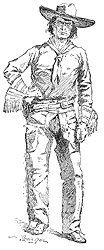 |

| Photos From Wyoming Tales and Trails This Page: Theodore Roosevelt's visit to Yellowstone continued. |
 |
|
|
|
About This Site |
|
From Tower Creek, President Roosevelt returned to Fort Yellowstone on April 16. The next day, the party set out for the Norris Basin.
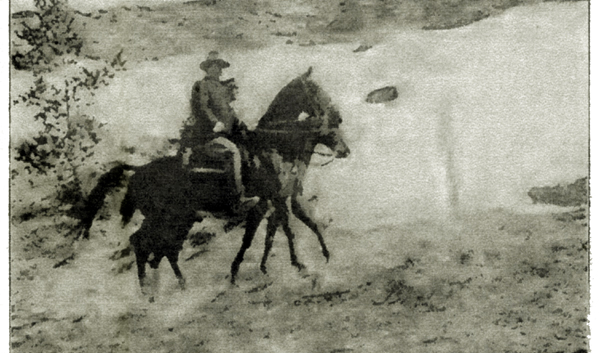 Theodore Roosevelt and Major Pitcher setting out Yellowstone Park, 1903 By the time they reached Golden Gate because of the depth of the snow, the party had to switch to box sleighs with the President and John Burroughs perched upon the camping gear.
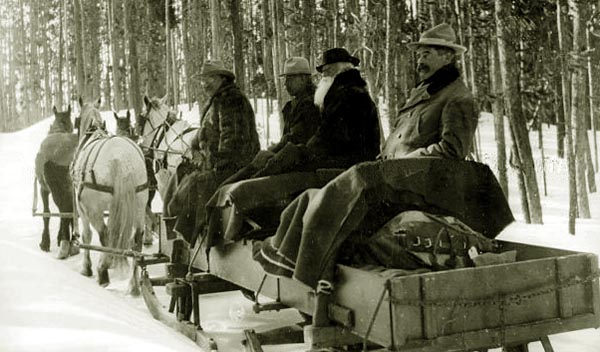 President Roosevelt and John Burroughs on way to Norris Basin, Yellowstone Park, 1903 Newspaper accounts of the journey referred to Golden Gate as "Modern Gate." See San Francisco Call, April 24, 1903, p. 3. The president was not accompanied by a gaggle of media. Thus actual reports of the president's adventures were only after he returned from the wilderness. In the meantime, the press was limited to speculation. One report had the president "hunting mountain lions twenty-five miles from Yanceys, on Slough Creek, and it is reported that he killed one." In actuality, before setting out, the president announced that he would under no circumstances fire a shot in the park, even if tempted to so so by a mountain lion up a tree, lest he should give people ground for criticism. He did not even carry a gun. When he set out alone to see mountain sheep, Major Pitcher insisted that he carry a revolver. The president fired one shot at a tree. It was a new gun, misfired and cut the president on the face. The lack of news caused the New York Morning Tribune, April 22, 1903, to complain: President Roosevelt on his trip through Yellowstone Park did not fall into a canyon, was not attacked by a bear, was not showered with hot liquid from a geyser, and was not almost lost in the snow. The President needs a new press agent.
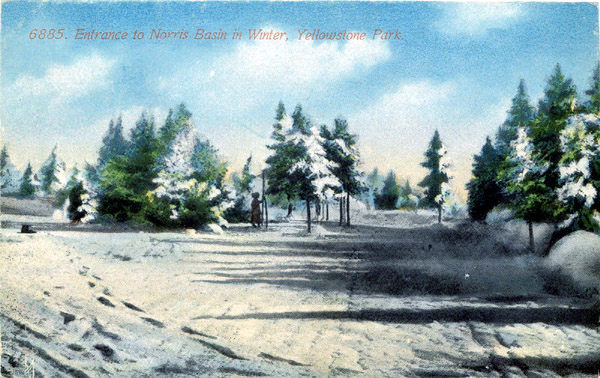 Entrance to Norris Basin, winter, Acmegraph, approx. 1911. The geyser areas impressed Mr. Burroughs mightedly. He noted: As one nears the geyser region, he gets the impression from the columns of steam going up here and there in the distanceŚnow from behind a piece of woods, now from out a hidden valleyŚthat he is approaching a manufacturing centre, or a railroad terminus. And when he begins to hear the hoarse snoring of "Roaring Mountain," the illusion is still more complete. At Norris's there is a big vent where the steam comes tearing out of a recent hole in the ground with terrific force. Huge mounds of ice had formed from the congealed vapor all around it, some of them very striking
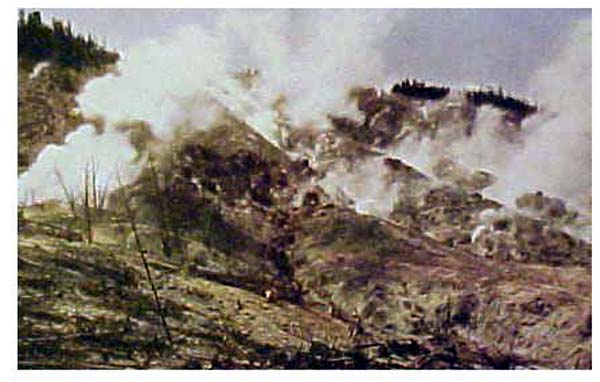 Yellowstone, Roaring Mountain. Although by 1903, there were several modern hotels in the Park, for the most part to thoroughly see the park required camping. The President did, however, stay at the hotels at Mammoth and at Norris.
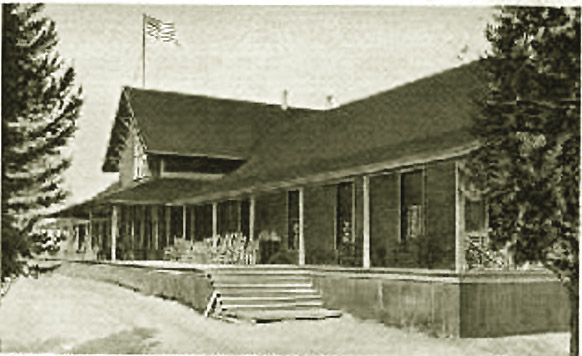 Hotel Norris, NOrris Geyser Basin, approx 1910. At the time of the President's visit, the hotel at Norris Basin was only two years old, replacing and earlier barn-like structure which burned in 1892. The President and Mr. Burroughs shared a room in the hotel. The President opened the floor to ceiling window into the cold air. The caretaker of the hotel marveled that with the open window there was no armed soldier outside guarding the President's room.
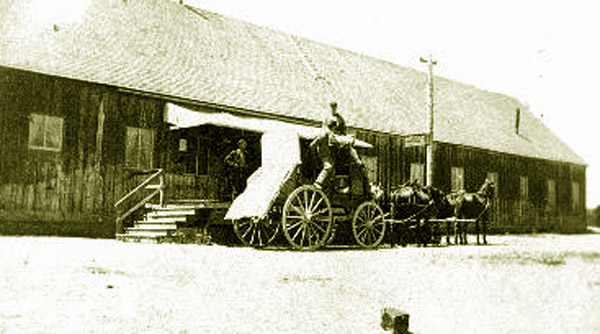 Hotel at Norris Basin, approx 1892. The 1892 hotel itself replaced an earlier 1887 hotel which burned within one year of its opening.
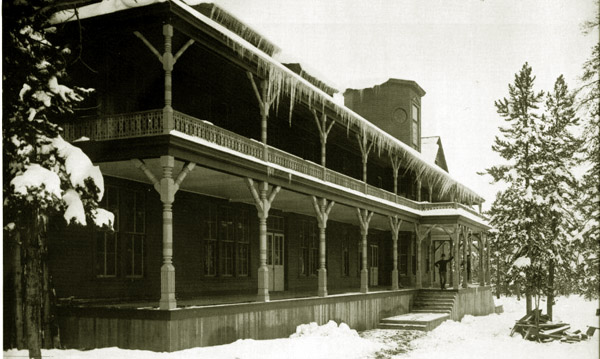 Hotel at Norris Geyser Basin, 1887. After spending the night at Norris, the presidential party headed out to Canyon. The snow was deep and it was necessary to use snow shoes. Mayor Pitcher commented that the President showed skill whilst "Mr. Burroughs proved himself an apt scholar." The next day it was back to Mammoth where a reception was held. On the 24th he dedicated the Arch. Although visits to Yellowstone at first were difficult, by the time of President Rossevelt's visit facilities were for the most part thoroughly modern. In a promotional book published by Secretary of State Fenimore Chatterton in 1904, a tourist's access to Yellowstone was described: The Union Pacific and its branch, the Oregon Short Line, bring the traveler to Monida, a station on the boundary of Montana and Idaho. Here he exchanges the Pullman for the modern Concord coach, which the Monida and Yellowstone Stage Company has in readiness for him. Although a day's ride from the boundary of the park, a tourist is seldom found who cares to forget that first day's coaching. The invigorating air, the ever-changing view of mountain and lake, good horses, a good driver and good means at every station, combine to drive into the background the cares of his workaday life. This route connects with the belt line at the Fountain Hotel in the Lower Geyser Basin.Secretary of State Chatterton assured visitors of the hotel rates: Hotel rates are four dollars per day. There are four modern hotels with electric light, baths and telegraphic communication with all parts of the world. These are so situated that the coaches reach tem before an early dinner hour and leave after breakfast. The midday meal is procured at lunch stations conveniently placed between the hotels.
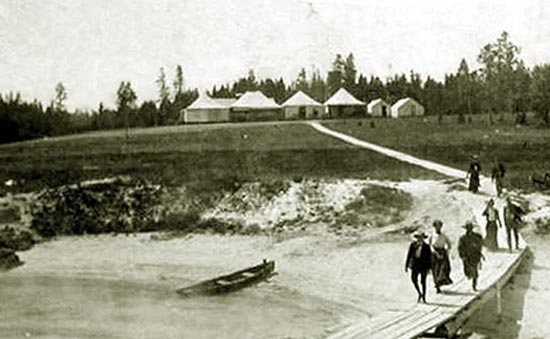 Lunch Station at West Thumb, undated. For those who could not afford the extravagance of the hotels, camping companies provided a less expensive experience: The Wylie Camping Company furnishes still another way of doing the park. It stands in about the same relation to the two just described that na accommodation train does to the Pullman flyer. One travels the same road and has the same views, but from a two-horse spring wagon instead of a four-hourse Concord coach. He sleeps in a tent, dines from a camp table, and pays thirty-five dollars for his week in the park.Writer's note: "An accommodation train" a "local" as compared to an express or through train. And for those who could not afford the expense of the camping companies, a third less expensive alternative was available: Last of all comes the independent camper, who cooks his meals in the geyser wells, finds plenty of suitable camping places, and may have a very good time with small expense, if he is careful to quench his camp fire and keeps his dog tied under the wagon, or, better still, leaves him at home. 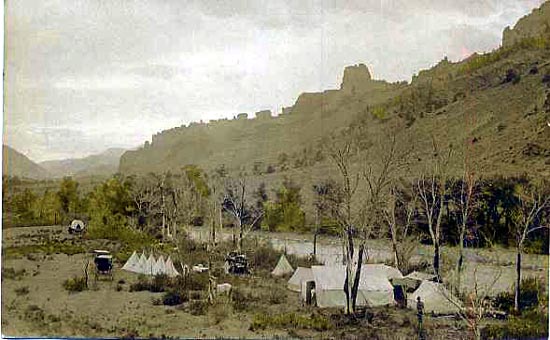 Camping in Yellowstone, Approx. 1910. Presidents Arthur and Roosevelt were not the only president to visit the Park. President Taft when he was Secretary of War visited the Park in 1907. Possibly because of his girth, he toured in a coach.
Next Page, Yellowstone continued, the visit by President Harding. |

